奈达翻译理论
- 格式:doc
- 大小:46.00 KB
- 文档页数:11
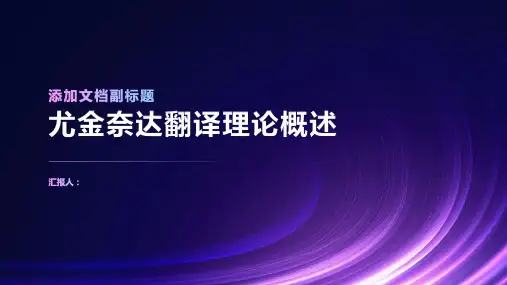
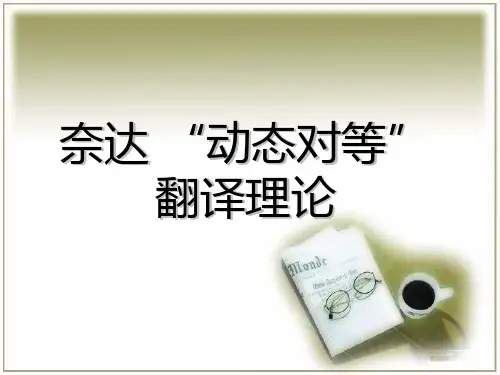
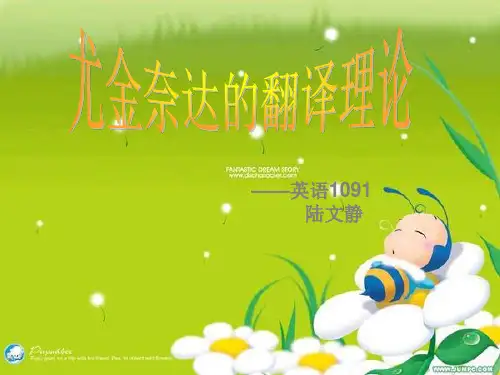
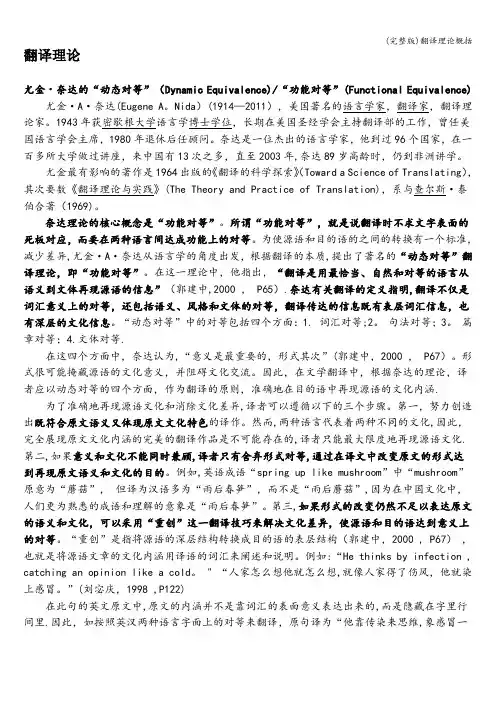
翻译理论尤金·奈达的“动态对等”(Dynamic Equivalence)/“功能对等”(Functional Equivalence)尤金·A·奈达(Eugene A。
Nida)(1914—2011),美国著名的语言学家,翻译家,翻译理论家。
1943年获密歇根大学语言学博士学位,长期在美国圣经学会主持翻译部的工作,曾任美国语言学会主席,1980年退休后任顾问。
奈达是一位杰出的语言学家,他到过96个国家,在一百多所大学做过讲座,来中国有13次之多,直至2003年,奈达89岁高龄时,仍到非洲讲学。
(Toward a Science of Translating),尤金最有影响的著作是1964出版的《翻译的科学探索》其次要数《翻译理论与实践》(The Theory and Practice of Translation),系与查尔斯·泰伯合著(1969)。
奈达理论的核心概念是“功能对等”。
所谓“功能对等”,就是说翻译时不求文字表面的死板对应,而要在两种语言间达成功能上的对等。
为使源语和目的语的之间的转换有一个标准,减少差异,尤金·A·奈达从语言学的角度出发,根据翻译的本质,提出了著名的“动态对等”翻译理论,即“功能对等”。
在这一理论中,他指出,“翻译是用最恰当、自然和对等的语言从语义到文体再现源语的信息”(郭建中,2000 , P65).奈达有关翻译的定义指明,翻译不仅是词汇意义上的对等,还包括语义、风格和文体的对等,翻译传达的信息既有表层词汇信息,也有深层的文化信息。
“动态对等”中的对等包括四个方面:1. 词汇对等;2。
句法对等;3。
篇章对等;4.文体对等.在这四个方面中,奈达认为,“意义是最重要的,形式其次”(郭建中,2000 , P67)。
形式很可能掩藏源语的文化意义,并阻碍文化交流。
因此,在文学翻译中,根据奈达的理论,译者应以动态对等的四个方面,作为翻译的原则,准确地在目的语中再现源语的文化内涵.为了准确地再现源语文化和消除文化差异,译者可以遵循以下的三个步骤。
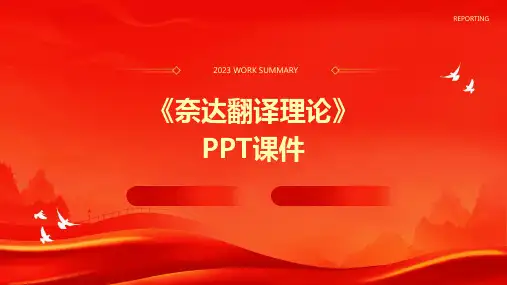
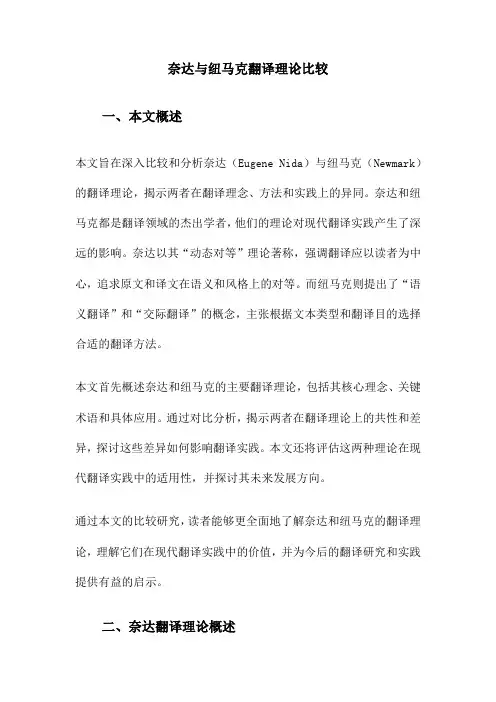
奈达与纽马克翻译理论比较一、本文概述本文旨在深入比较和分析奈达(Eugene Nida)与纽马克(Newmark)的翻译理论,揭示两者在翻译理念、方法和实践上的异同。
奈达和纽马克都是翻译领域的杰出学者,他们的理论对现代翻译实践产生了深远的影响。
奈达以其“动态对等”理论著称,强调翻译应以读者为中心,追求原文和译文在语义和风格上的对等。
而纽马克则提出了“语义翻译”和“交际翻译”的概念,主张根据文本类型和翻译目的选择合适的翻译方法。
本文首先概述奈达和纽马克的主要翻译理论,包括其核心理念、关键术语和具体应用。
通过对比分析,揭示两者在翻译理论上的共性和差异,探讨这些差异如何影响翻译实践。
本文还将评估这两种理论在现代翻译实践中的适用性,并探讨其未来发展方向。
通过本文的比较研究,读者能够更全面地了解奈达和纽马克的翻译理论,理解它们在现代翻译实践中的价值,并为今后的翻译研究和实践提供有益的启示。
二、奈达翻译理论概述奈达(Eugene Nida)是当代西方翻译理论界极具影响力的人物,他提出的翻译理论被誉为“功能对等”或“动态对等”理论。
奈达的翻译理论主要基于两个核心概念:形式对等(formal equivalence)和动态对等(dynamic equivalence)。
形式对等,也被称为字面对等,指的是译文尽可能地复制原文的语言形式,包括词汇、语法、句子结构等。
奈达认为,这种对等方式主要适用于那些具有重大历史、文化和文学价值的文献翻译,因为这些文献的语言形式本身就是其意义的重要组成部分。
然而,奈达更加强调的是动态对等,也就是译文应该在传达原文语义和风格上达到对等,而不是在语言形式上。
他认为,翻译的主要目的是使译文读者能够像原文读者一样理解和欣赏原文,因此,翻译过程中应当考虑到译文读者的语言习惯和文化背景。
为了实现动态对等,奈达提倡译者在翻译过程中进行适当的调整和重构,包括词汇选择、句子结构、修辞手法等方面的调整。
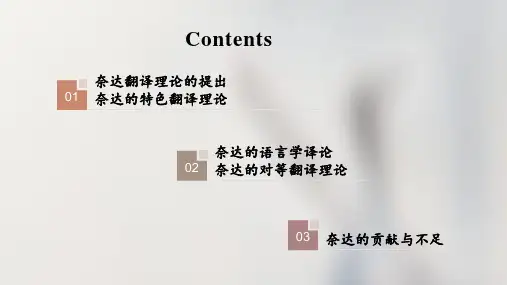


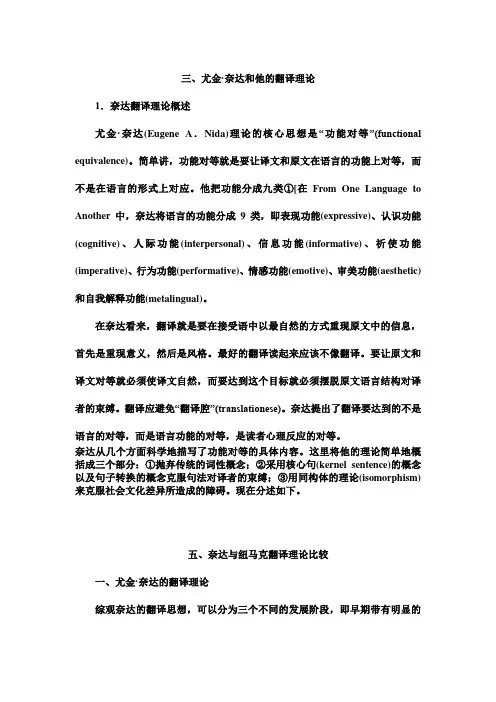
三、尤金·奈达和他的翻译理论1.奈达翻译理论概述尤金·奈达(Eugene A.Nida)理论的核心思想是“功能对等”(functional equivalence)。
简单讲,功能对等就是要让译文和原文在语言的功能上对等,而不是在语言的形式上对应。
他把功能分成九类①[在From One Language to Another中,奈达将语言的功能分成9类,即表现功能(expressive)、认识功能(cognitive)、人际功能(interpersonal)、信息功能(informative)、祈使功能(imperative)、行为功能(performative)、情感功能(emotive)、审美功能(aesthetic)和自我解释功能(metalingual)。
在奈达看来,翻译就是要在接受语中以最自然的方式重现原文中的信息,首先是重现意义,然后是风格。
最好的翻译读起来应该不像翻译。
要让原文和译文对等就必须使译文自然,而要达到这个目标就必须摆脱原文语言结构对译者的束缚。
翻译应避免“翻译腔”(translationese)。
奈达提出了翻译要达到的不是语言的对等,而是语言功能的对等,是读者心理反应的对等。
奈达从几个方面科学地描写了功能对等的具体内容。
这里将他的理论简单地概括成三个部分:①抛弃传统的词性概念;②采用核心句(kernel sentence)的概念以及句子转换的概念克服句法对译者的束缚;③用同构体的理论(isomorphism)来克服社会文化差异所造成的障碍。
现在分述如下。
五、奈达与纽马克翻译理论比较一、尤金·奈达的翻译理论综观奈达的翻译思想,可以分为三个不同的发展阶段,即早期带有明显的美国结构主义色彩的语言学阶段;中期的翻译科学说与翻译交际说阶段,以及后来的社会符号学阶段.1.2.3 动态对等说这是奈达翻译理论中最为人熟知的一种观点。
所谓动态翻译,就是在翻译交际理论指导下的翻译,即“从语义到语体,在接受语中用贴近原文的自然对等语再现源语信息”。

奈达功能对等翻译理论(Nida's Functional Equivalence Theory)是基于语言功能和交际目的的翻译理论,由美国翻译学家尤金·奈达(Eugene Nida)提出。
该理论认为,翻译的目的在于传达源语言(原文)的信息,使得译文的接受者能够理解并接受这些信息。
因此,译者应该根据翻译的目的和受众的需求,选择合适的翻译方法,实现翻译的功能对等。
奈达认为,翻译的功能对等可以分为两种类型:动态对等和形式对等。
动态对等(dynamic equivalence)强调翻译的功能目的,即将源语言的信息转化为译语(目标语言)的信息,以达到与原文相同的功能目的。
而形式对等(formal equivalence)则强调词汇和语法结构的相似性,使译文与原文的表面形式尽量相似。
奈达功能对等翻译理论强调了翻译的交际功能,即翻译的主要目的是传达信息,而不是简单地将原文单词和句子的翻译转换为另一种语言。
因此,译者需要考虑到受众的语言和文化背景,选择恰当的语言和表达方式,以实现源语言和目标语言之间的功能对等。
奈达翻译理论奈达翻译理论是一种重要的翻译理论,由德国学者让·奈达于20世纪60年代提出。
奈达翻译理论的核心思想是“等效”,即在翻译过程中,要求译文与原文在意义上等效。
奈达认为,通过对原文的分析和解构,翻译者可以理解原文的思想和意图,并将其准确地转化为译文。
根据奈达的观点,翻译是一种创造性的过程,翻译者需要在保持原文信息的基础上,根据不同语言和文化的特点,使用适当的词汇和结构来表达原文的含义。
奈达认为,翻译不是简单的语言转换,而是一种文化传递和交流的行为。
奈达提出了三个翻译原则,即“翻译为读者”、“翻译为现实”和“翻译为对等”。
首先,“翻译为读者”意味着翻译应该根据目标读者的语言能力和文化背景来选择合适的翻译策略和技术。
其次,“翻译为现实”强调翻译应根据当时的社会、政治和文化背景来进行,以保持译文的时效性和可读性。
最后,“翻译为对等”指的是翻译应该在语言和文化的不同中寻求最佳的等效性,以使译文与原文在意义上相等。
在奈达的翻译理论中,译者的主观能动性被强调。
奈达认为,翻译是一种创造性的行为,翻译者应该根据自己的理解和判断来进行翻译。
因此,奈达认为,译者不仅仅是一种技术工人,而是一种文化中介和创作者。
然而,奈达的翻译理论也有一些问题。
首先,奈达的等效理论存在一定的主观性和个人判断。
在实际翻译过程中,不同的译者可能会根据自己的认知和经验得出不同的译文,导致译文的多样性。
其次,奈达的翻译理论忽视了翻译的政治和权力关系。
翻译不仅仅是一种文化交流,而且也是一种权力关系的体现,翻译者的选择和判断受到不同文化和社会背景的影响。
总的来说,奈达翻译理论对于翻译的创造性和主观能动性的强调有积极意义,但在具体操作上仍需兼顾客观性和客观规则。
翻译者应该在创造译文的同时,也要考虑到读者的需求和文化背景,以达到最佳的翻译效果。
奈达和纽马克翻译理论对比在翻译理论的领域中,有许多重要的理论家提供了不同的翻译方法和策略。
奈达和纽马克是其中最著名的两位理论家。
他们在翻译领域中做出了杰出的贡献,并且影响了现代翻译理论和实践。
本文旨在比较和分析奈达和纽马克的翻译理论和方法,探讨它们的异同以及它们可以为翻译实践和教育带来的启示。
一、奈达的翻译理论奈达是20世纪最著名的翻译理论家之一。
他认为翻译应该是一个文化的交流过程,而非简单的语言转换或词语的替换。
他主张翻译应该注重跨文化交际的效果,即传达源语言意义的同时,也要保持目标语的文化和风格特征。
他建立了“动态对等”和“跨文化适应”等重要翻译概念。
他认为翻译是一种在不同文化之间进行的交互作用,翻译过程应该尊重源语言和目标语言的文化特征,避免出现过度文化低头和过度文化抬头的现象,形成恰当的文化平衡。
二、纽马克的翻译理论纽马克提出的“功能翻译”理论反对了奈达的“动态对等”和“跨文化适应”理论。
他认为翻译是一种语言功能转换,不需要考虑文化差异。
他提倡翻译需要满足目的语文化环境的语用需求,并通过翻译来达成源语和目标语之间的交际目的。
他强调翻译需要注重语言的功能、规范和习惯用法,而不是纠缠于语言的形式和词汇的对应关系。
三、奈达和纽马克的翻译理论比较两位理论家的观点存在显著的区别。
首先,他们对翻译对象的认识不同。
奈达认为翻译应该是跨文化交际,注重文化因素、词汇的多义性。
而纽马克则认为翻译是语言功能转换,更注重语用环境。
其次,两位理论家在语言层面上的关注点不同。
奈达主张翻译是跨文化交际,强调译文的文化因素,而纽马克则更加注重翻译所需的语言功能、规范和习惯用法。
四、奈达和纽马克翻译理论给翻译实践和教育带来的启示奈达和纽马克的翻译理论都带来了对翻译研究和实践的启示。
从奈达的理论中我们可以看出,翻译应该是一种双向的文化交流,尊重源语和目标语的文化特征。
因此,在实践中,中译英或英译中时,译者应该注重文化差异和语言风格的不同。
奈达翻译理论奈达翻译理论是由20世纪50年代英国外语学家约翰·奈达提出的翻译理论,被视为对传统的文本对照翻译理论的补充和发展。
奈达翻译理论基于语言、社会、文化等跨学科的思想,强调翻译的表达功能和文体特征,注重原文的内容、文化背景以及读者的需要,批判性地发现翻译中存在的问题,提出了符合目标语文化特点的翻译技巧以及新的翻译方法,是对传统翻译理论的重要补充和发展。
奈达翻译理论反对将翻译视为一种“文本对照”的传统观念,而是倡导从文化角度出发,将翻译视为一种把原语文化转换为目标语文化的活动。
奈达宣称“翻译不是一种文字狗,而是一种文字艺术”,把翻译看作对原文的创造性重组,而非对原文的单一重复。
他认为,翻译的任务是补充原文,使原文的思想成分通过一种新的形式达到一种符合目标语文化的表达效果。
因此,奈达强调翻译的表达功能,提出“意群”概念,将翻译视为一种综合考虑宏观素材、原文文体特征、译文读者要求等多种因素以实现关联翻译的过程。
奈达翻译理论把翻译从盲目的文本对照解放出来,从文化角度出发,强调原文内容、文化背景以及读者的需要。
奈达认为,翻译必须重新创造原文的意义,把原文的思想成分传达给目标语文化的读者,而不是仅仅复制原文的形式。
所以,翻译时需要考虑原文和目标语文化之间的差异,如文化习俗、思维习惯、概念表达等。
在翻译中,应该考量语言因素和文化因素,以达到符合目标语文化特点的翻译技巧和方法。
总之,奈达翻译理论以多学科的视角,强调翻译的表达功能,提出以实现汉语与其他语言之间的文化交流的技巧和方法,是对传统的文本对照理论的重要补充和发展。
对奈达翻译理论研究的重新审视字体大小:大- 中- 小xiamenmts 发表于11-01-18 17:59 阅读(291) 评论(0) 分类:翻译管理对奈达翻译理论研究的重新审视——从奈达翻译定义的错误译文谈起李田心广东外语外贸大学南国商学院中文摘要:本文指出并分析奈达翻译定义的中文译文中的错误,提供参考译文,指出奈达不主张“等值”、“等效”翻译。
“等值”、“等效”、“对等”、“对等语”,“动态对等”,“功能对等”等术语是错误的术语,它们用一个“等”字曲解了奈达翻译理论的本质,将奈达翻译理论曲解成求等的翻译理论,然而奈达翻译理论的本质是求似不求等。
文章建议澄清错误译文在译界产生的巨大影响。
关键词:尤金,奈达,翻译定义,错误译文Chinese Translation Theorists Should Reread Nida’s Translation Theory—Comments from the Wrong Translations of Nida’s Translation Abstract: The writer of this paper points out and analyses the mistakes in the Chinese translation of Eugene A·Nida’s definition for translation. A reference translation by the writer is provided. In this paper the suggestion is made that the great influence caused by the wrong translations should be liquidated.Key Words: Eugene A· Nida, translation definition, wrong translation在现在的中国译论界,尤金·奈达(Eugene A·Nida)的名字如雷贯耳,它的响亮程度不亚于严复。
究其原因,是他的“等值”、“等效”翻译原则在我国产生了轰动效应。
上世纪80年代以来,译界几乎人人言必称奈达,言必称奈达的等值“、“等效”翻译原则。
有人认为翻译的“等值”或“等效”翻译标准,在于使信息量化,以便科学传达言语信息。
机器翻译的出现和发展,对语言信息的量化提出了新的要求。
在这种情况下,老的翻译标准不适用了,而等值标准显示它的优越性。
(1)翻译涉及的是语言文字,语言文字表达意义,神韵和风格。
意义、神韵和风格不能量化。
现代语言学或翻译学没有提供量化意义、神韵和风格的方法,人们无法对意义、神韵和风格计量。
“等值”、“等效”翻译的提法貌似科学,其实不科学。
奈达是世界著名的语言学家兼翻译家,他清楚地知道语言的文本意义不可能一点一滴地落实,也不存在什么“全部意义”。
不同语言之间的形式差异和它们所蕴含的文化差异造成了翻译中的许多不可译因素,他不可能提出“等值”或“等效”翻译原则。
请看他在The Theory and Practice of Translation (2)中的翻译定义。
Translation consists in reproducing in the receptor language the closest natural equivalent of the source language message, first in terms of meaning and secondly in terms of style。
奈达的翻译定义没有一点“等值”、“等效”翻译的痕迹。
定义自始至终无“等效”或“等值”二词出现,也没有“对等”之义。
笔者见过的20多种奈达定义的译文都很值得商榷。
现将其中一种译文引用如下并加以分析(其他译文与此译文大同小异):翻译是在译入语中用最切近的、最自然的对等语再现原语的信息,首先指语义上的对等,其次是风格上的对等。
此译文至少有以下7处值得商榷。
1.“首先指语义上的对等,其次是风格上的对等”,奈达的原文根本没有要求这两方面的对等。
“对等”是精确词,100%对100%才是对等。
2.“在译入语中用最切近的、最自然的对等语”,此处的“对等语”是什么意思?译入语中存在一种“对等语”吗?英译汉时,汉语是译入语,汉语中的“对等语”是什么语呢?奈达的定义中没有“对等语”一词。
另外译文中的“用”字在原文中体现在何处?这是误译,也是“等效”、“等值”翻译的来源。
有译论家评论说:“奈达的定义增加了‘信息’和‘对等’这样的概念,蕴含了翻译的‘等值标准’的意义”。
其实,奈达的定义的原文没有“对等”的意思。
这是译文引起的误解。
3.原文“reproducing in the receptor language the closest natural equivalent of the source language”中的“in the receptor language”的中文意义是“用接收语”,不是“在译入语中”。
其中的“in”是“用”的意思,相当我们平时说的speak in English或write in the Chinese language中的“in”。
“speak in English”译成中文是“用英语说”,不是“在英语中说”。
“write in the Chinese language”的中文译文是“用中文写”,不是“在中文中写”。
4.“equivalent”虽然有“相等”或“对等”的意义,但此处不应译成“对等”。
这是很关键的一词。
根据上下文,再查阅原文词典,此词意义为“相当的”、“相对的”或“对应的”。
请看下列词典对“equivalent”一词的解释。
4.1《牛津当代大词典》(英汉双解)(3)p589, equivalent adj. …, 4,相当的,相对的(corresponding)。
4.2《韦氏新世界学生词典》(4)p346, equivalent adj. 相等的,相当的,…Three teaspoonfuls are the equivalent of one tablespoonful.3茶匙相当于1汤匙。
4.3《新英汉词典》(5)p404, equivalent 1 a. (在力量等上)相等的,相当的,相同的:be equivalent to等于,相当于。
4.4定义中的“equivalent”是名词,因为它被closest和natural所修饰。
“equivalent”有两种词性,一是形容词,二是名词。
当它是名词时,其意义是sth that is equivalent(《柯灵斯英语词典》p495),因此名词“equivalent”一词有两种意义,一是“相等”,二是“相当”。
如果“equivalent”的意义是“相等”,前面不能加形容词“the closest”,即不能说“the closest equivalent”(最接近的相等);反之,这样说就不合符逻辑。
如果“equivalent”的意义是“相当,前面可以加形容词“the closest”,即可以说“the closest equivalent”(最接近的相当)。
综上所述,“equivalent”不能译成“对等”,只能译成“对应”或“相当”。
5.“最自然的对等语”原文“The closest natural equivalent of the source language”中的“natural”不能译成“最自然的”,“natural”是原级形容词,不是最高级。
6.“用最切近的、最自然的对等语再现原语的信息”按照译者的理解,译入语中存在“对等语”。
读者不明白,既然存在对等语,为什么不用对等语去再现原语的信息而用最切近的对等语去再现原语的信息呢?这不是与所谓的“等值”翻译原则相矛盾了吗?用最切近的对等语再现原语的信息是达不到“等值”翻译的效果的。
7.怎样理解“equivalent of the source language message”是译好此定义的关键。
“equivalent”是名词,其意义是“对等物”或“对应物”。
“equivalent of the source language message”的意义是“源语信息的对等物或对应物”,即与源语信息对等或对应的信息。
“equivalent”不能译成“对等语”,可以译成“对应语”或“相当的词”,但要看它所处的语境。
例如,“Some American words have no British equivalents”可以译成“一些美国英语词语在英国英语中没有相当的词语”。
“equivalent of the source language message”中的“equivalent”不能译成“对应语”或“相当的词”,更不能译成“对等语”,因为它后面的限制语是“the source language message”,而不是“the source language”。
然而有些译论家却将“equivalent”译成了“对等语”。
这样的翻译,就产生了误解,读者会跟上文第2点所引用的引文一样理解,认为奈达的定义蕴含了等值标准的意义。
更为严重的是,有些译论家将“reproducing the closest natural equivalent of the source languagemessage”译成“用最切近的、最自然的对等语再现原语的信息”。
此译文给读者非常严重的误导。
此译文言下之意是奈达主张翻译用最切近的对等语翻译。
退一步说,那使将“对等语”理解为与“对应语”,同义,那么翻译也是用“对应语”翻译。
在此译文的误导下,译论界许多人认为奈达的翻译原则是,翻译不仅要在译语中寻找顺乎自然的对等语,而且还要找到最切近的对等语。
也就是说只能直译,不能意译。
“good clothes”只能译成“好的衣服”,不能译成“衣冠楚楚”。
“kill two birds with one stone”也只能译成“用一块石头杀死两只鸟”,不能译成“一石二鸟”、“一箭双雕”或“一举两得”。
“…mais, trois jours apre’s Julien, elle mourut en embrassant ses enfants”只能译“然而,于连死后三天,她拥抱着孩子们去世了”。
不能译成“但在于连死后三天,她也吻着孩子,魂归离恨天了”。
严格地说,按照上述译文,“elle mourut”与英文“she died”等值,“she died”与汉语“她死了”对应,因此将“elle mourut”译成“她去世了”也不行,因为“去世了”不是“died”的最切近的对等语,唯一的译文只能是“她死了”。